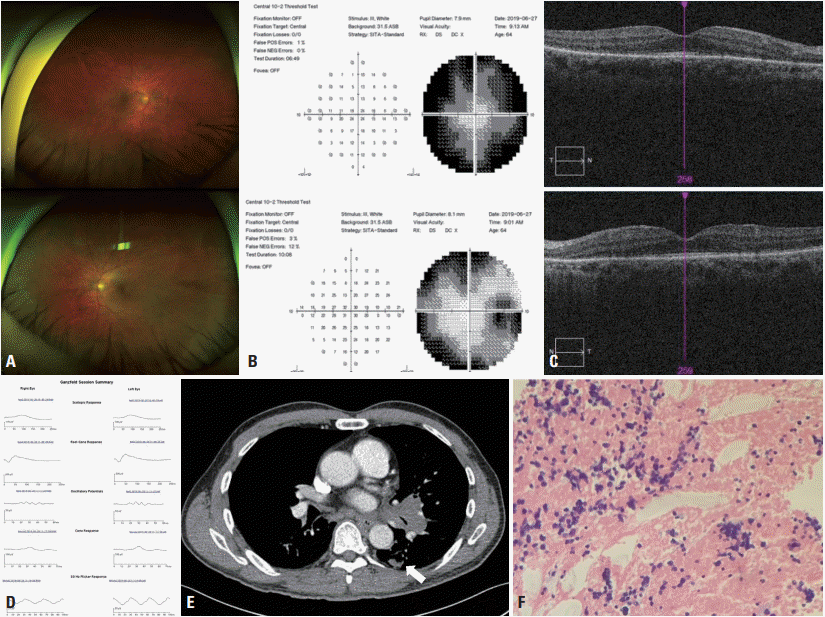 | Fig. 1.. Findings of ophthalmology, imaging, and pathology examinations. (A) Fundoscopy produced normal findings in both eyes (upper: right eye, lower: left eye). (B) Humphrey visual field demonstrating generalized field constriction with a sparing of the central vision in both eyes (upper: right
eye, lower: left eye). (C) Optical coherence tomography shows loss of the outer limiting membrane at the junction of the inner and outer segments with sparing of the central region (upper: right eye, lower: left eye). (D) Electroretinogram reveals diffused decreased wave potentials for all stimuli. (E) Chest computed tomography reveals a 1.8 cm nodule with adjacent tiny nodules in a superior segment of the left lower lobe (arrow). (F) Immunohistochemistry of a lymph node demonstrates metastatic small-cell carcinoma. Hematoxylin and eosin staining (×200) of the biopsy specimen revealed proliferation comprising small cells with hyperchromatic nuclei infiltrating the lymph node. |
A 64-year-old man developed progressive visual field defects in bitemporal sites without any vision loss or ophthalmic pain over 1 month. His visual acuity was 0.9 in the right eye and 0.9 in the left eye. The optic fundi were unremarkable (Fig. 1A). There was no relative afferent pupillary defect, and the findings of the color vision test were normal. The Humphrey visual field demonstrated generalized field constriction with sparing of the central vision in both eyes (Fig. 1B). Optical coherence tomography revealed thinning of the outer retinal layer (Fig. 1C). Electroretinograms showed decreased wave potentials for all stimuli (Fig. 1D). Brain and orbit magnetic resonance imaging produced normal findings. Paraneoplastic antibody assays were conducted due to the unexplained bilateral vision loss, which revealed positivity for the antirecoverin antibody. Chest computed tomography searching for hidden malignancy revealed a 1.8 cm nodule and multiple enlarged lymph nodes (Fig. 1E). A biopsy investigation of the lymph nodes confirmed small-cell lung cancer (Fig. 1F).
Cancer-associated retinopathy (CAR) is a paraneoplastic autoimmune retinopathy, and the most commonly identified autoantibody of CAR is targeted against recoverin [1]. Recoverin is an intracellular calcium-binding protein expressed in the retinal photoreceptor cells that regulates the phosphorylation of rhodopsin [1]. Recoverin is aberrantly expressed in tumors of patients with CAR, and is distributed in the outer segment of the rod cells in the retinal periphery [2]. Antirecoverin antibody against tumor-expressed recoverin cross-reacts with photoreceptors to generate diffuse retinal degeneration [2]. CAR typically presents with bilateral, progressive visual loss over days to years and a significantly constricted visual field [2]. Whereas the optic fundi initially appear normal, there may be abnormalities of both the a- and b-waves on an electroretinogram, with selective involvement of the b-wave. The present findings indicating that searching for antiretinal antibodies and hidden malignancy may be required in adults with unexplained visual loss.




 Citation
Citation Print
Print



 XML Download
XML Download